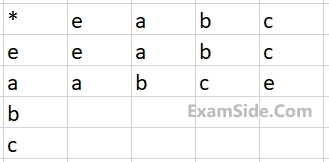1
GATE CSE 2004
MCQ (Single Correct Answer)
+2
-0.6
The inclusion of which of the following sets into
S = { {1, 2}, 1, 2, 3}, {1, 3, 5}, {1, 2, 4},
{1, 2, 3, 4, 5} }
Is necessary and sufficient to make S a complete lattice under the partial order defined by set containment?
2
GATE CSE 2004
MCQ (Single Correct Answer)
+2
-0.6
The following is the incomplete operation table of a 4-element group.
 The last row of the table is
The last row of the table is
 The last row of the table is
The last row of the table is 3
GATE CSE 2002
MCQ (Single Correct Answer)
+2
-0.6
The binary relation $$S = \phi $$ (emply set) on set A = {1, 2, 3} is
4
GATE CSE 2001
MCQ (Single Correct Answer)
+2
-0.6
Consider the following statements:
S1: There exist infinite sets A, B, C such that
$$A\, \cap \left( {B\, \cup \,C} \right)$$ is finite.
S2: There exist two irrational numbers x and y such that (x + y) is rational.
Which of the following is true about S1 and S2?
Questions Asked from Marks 2
GATE CSE 2025 Set 2 (1) GATE CSE 2025 Set 1 (1) GATE CSE 2024 Set 2 (1) GATE CSE 2024 Set 1 (1) GATE CSE 2023 (2) GATE CSE 2021 Set 2 (1) GATE CSE 2021 Set 1 (1) GATE CSE 2018 (1) GATE CSE 2016 Set 2 (2) GATE CSE 2016 Set 1 (1) GATE CSE 2015 Set 3 (1) GATE CSE 2015 Set 2 (2) GATE CSE 2014 Set 3 (2) GATE CSE 2014 Set 2 (1) GATE CSE 2014 Set 1 (1) GATE CSE 2012 (1) GATE CSE 2009 (1) GATE CSE 2007 (4) GATE CSE 2006 (4) GATE CSE 2005 (3) GATE CSE 2004 (2) GATE CSE 2002 (1) GATE CSE 2001 (2) GATE CSE 2000 (2) GATE CSE 1999 (1) GATE CSE 1998 (3) GATE CSE 1996 (3) GATE CSE 1995 (1) GATE CSE 1994 (1) GATE CSE 1989 (1) GATE CSE 1988 (1)
GATE CSE Subjects
Theory of Computation
Operating Systems
Algorithms
Digital Logic
Database Management System
Data Structures
Computer Networks
Software Engineering
Compiler Design
Web Technologies
General Aptitude
Discrete Mathematics
Programming Languages
Computer Organization